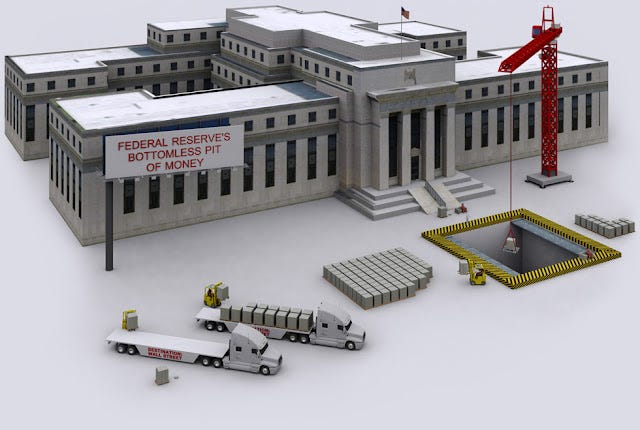Federal Reserve on Life Support
Last week, Chairman Jerome Powell announced the Federal Reserve’s decision to reverse a policy in place since President Trump’s election and begin once again enlarging the central bank’s balance sheet, programming the regular purchase of U.S. Treasury bonds and holding them until further notice. My, my, that sounds like a dry topic for a Friday, doesn’t it? And the manner in which financial journals and talking heads speak of Fed policy decisions such as this one is so outrageously dull that it’s almost like they want you to stop reading or turn the channel. But you owe it to yourself to stay with me here. When you understand what the Fed Chairman is doing and why, I venture to say it will catch your attention.
Consider the term, “quantitative easing.” The Fed uses it to create an impression in public mind that all this high finance stuff is beyond normal abilities to understand. Once that task is complete, they can do anything they want to do and no one will question them.
Now Powell is careful to say this new program of bond buying “is not QE.” He wants you to believe that QE, an emergency operation the Fed undertook after the 2008-9 financial crisis, is no longer necessary, and that matters have returned to a state of normalcy. Powell wants you to believe that this new round of bond purchases, enlarging the so-called Fed Balance Sheet, is simply a temporary program to satisfy a few short-term liquidity glitches in the banking system.
The truth is that anytime the Fed decides to lower target interest rates, to execute that maneuver it must increase the number of dollars in circulation. QE means, easing quantities of dollars into circulation to effectively buy-down interest rates.
But before we can go further, first you must know that the Fed holds U.S. debt as collateral for the issuance of dollars. Read that again, friends, and then ask yourself, if the Fed is part of the U.S. Government, why would it have to hold U.S. debt as collateral? How can the government be in debt to itself? It can’t. The Fed holds U.S. debt as collateral because the dollars it issues are not government dollars. They are private dollars. The Fed holds U.S. debt as a legal requirement for the American people to pay back all the private dollars it issues. Yes, you may have a dollar in your pocket. But it is not yours. Someone borrowed it and is still paying it back, with interest. When that dollar is finally paid back, it, or another one just like it, is removed from circulation.
So the fact that the Fed is buying up more and more U.S. debt means that they are seizing collateral for issuing more and more dollars into circulation. Those dollars get injected into circulation through U.S. Government spending. The simplest way to think about it is that the U.S. Government issues new debt in exchange for new dollars, then spends them into circulation. That’s how the money supply increases.
To lower prevailing interest rates, which is the goal here, using all those new dollars the Federal Reserve System conjures up, the Fed bids up the price of U.S. Treasury Bonds to a level higher than they are presently being bought and sold. That lowers the yield on those so-called “riskless assets,” which lowers interest rates on most other competing interest-bearing instruments as well.
Fed Printing Money to Stay Alive
What I describe is what many used to call, “money printing.” When governments and their associated central banks around the world resort to money printing, it is for a reason. Since more debt has already been issued than can ever be paid back, the only way to keep servicing the debt is to print more and more dollars, have the government borrow them, and spend them into circulation. Eventually, those dollars end up in the hands of those who need them to service their loans. And that’s how the debt service on all the dollars floating around in the world, borrowed at interest, can keep being paid.
So what happens when a certain critical amount of debt surpasses the number of dollars available to keep making the associated payments? That is where we are continuously. That is where we were in 2008-9 when Congress voted for the US Government to issue $700 billion dollars of debt, hand it over to the Fed as collateral, and allow the Fed to write checks to recapitalize the Wall Street banks that would have otherwise been forced into bankruptcy.
And unfortunately, the problem that brought the Federal Reserve System to its knees ten years ago has never been solved. It can’t be solved using only the present system. The problem is debt. One cannot pay back debt with more and more debt. Eventually the system must be reset. But to reset this system, while keeping the system, without a good excuse, is political infeasible. The people wouldn’t stand for another bailout on top of the previous bailout.
So how do you reset a system like this while leaving the system in place? War, that would be the excuse. That is where they, and Hillary Clinton would have taken us. But President Trump won’t go there. And so, hoping to outlast Trump in office, the Fed is resorting to money-printing, bond-buying and interest rate containing. The Fed is on programmed life support until it can muster an excuse to reset itself without destroying itself.




